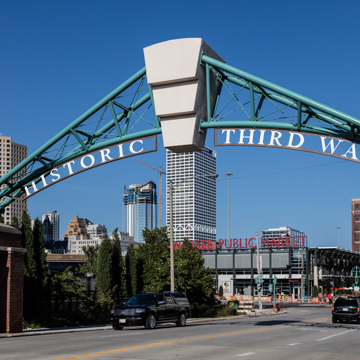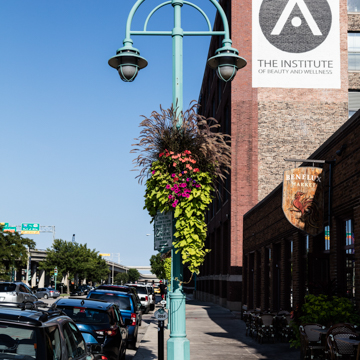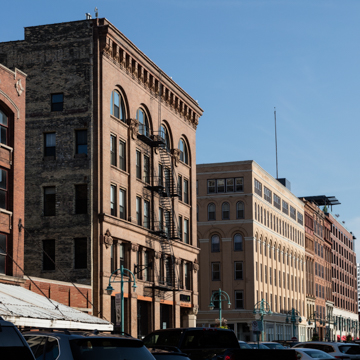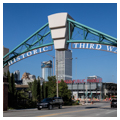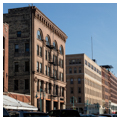A century ago, the Third Ward was the bustling heart of Milwaukee’s wholesale business. Though quieter now, it still boasts the state’s largest surviving cluster of turn-of-the-twentieth-century warehouses. Blocks filled with looming, flat-roofed brick structures, many abutting each other and pushing to the sidewalk, give the district a dense, urban appearance. The brick canyons display an impressive variety of architectural motifs and terra-cotta, metal, and stone ornament.
The Third Ward became the city’s leading factory and warehouse district by the late nineteenth century due to its location near the river, rail access, the harbor on Lake Michigan, and downtown commerce. Traders distributed goods to residents of Milwaukee, the rural areas of Wisconsin, and beyond. The district’s railroad, warehouse, and factory workers were mostly Irish immigrants who lived in hundreds of tiny frame cottages huddled on the marshy lakeshore to the east. In October 1892, fire in an oil warehouse destroyed over four hundred structures, including the houses of almost two thousand Irish laborers and their families. The rubble was bulldozed, and by 1900, large dark brick warehouses replaced smaller cream brick Italianate warehouses. Italian warehousemen supplanted the Irish residents. The Third Ward reemerged as Milwaukee’s busiest wholesale and light-manufacturing district. The concentrated rebuilding created a cohesive architectural character, maintained in recent years by exterior renovations and new construction. As warehousing moved to the suburbs, the upper stories of many buildings became vacant, but the area retained many grocery commission houses and small manufacturing, distribution, and retail firms. Recently a growing mix of specialty retail shops, loft apartments, and entertainment venues have moved into the district’s more than seventy structures. Among them are outstanding examples of classical, Romanesque Revival, High Victorian Gothic, and Queen Anne styles.
At the north end of the district sits one of the few Third Ward structures that survived the 1892 fire: the Jewett and Sherman Company Building (1875) at 343 N. Broadway. The extensive High Victorian Gothic ornamental brickwork includes hood molds over the windows. The building anchors the north end of the block-long “Commission Row,” the heart of the city’s wholesale produce trade since the beginning of the twentieth century. The block is notable for its long, rhythmic facade created by the repetition of projecting brick piers and other simple architectural elements. To most visitors, Commission Row looks quiet, but early every weekday morning throngs of fruit and flower merchants load their trucks under the broad metal awnings. The Baumbach Building (1900) is in the heart of the district at 302 N. Broadway. The building’s sturdy octagonal corner pier, topped with a carved capital featuring human faces, is one of the downtown area’s most frequently photographed architectural vignettes. The two public facades of brick are organized with characteristic Richardsonian Romanesque arches and topped by a heavy, bracketed terra-cotta cornice. The dignity of this structure speaks to the skill of its German-born designer, Eugene Liebert. Originally the building housed a factory where workers made clothing for lumberjacks and miners. Today it is used for offices and residential condominiums.
The George Hambach store at 221 N. Broad way (1895) is one of the finer small Queen Anne commercial buildings remaining in Milwaukee. The front of the building is profusely detailed with pressed sheet metal, ornamental brickwork, dressed stone, and decorative millwork, culminating in an attractive arched parapet. Unlike most of the large buildings in the district, which were used exclusively for industrial and commercial purposes, the Hambach Building was built to house two retail stores on the ground floor and above them a flat where the Hambach family lived. One of the finest structures in the southwest part of the Third Ward is the five-story Landauer Building warehouse at 200–208 N. Water Street(1895). The two principal facades are divided into three horizontal sections that organize its large facade.


